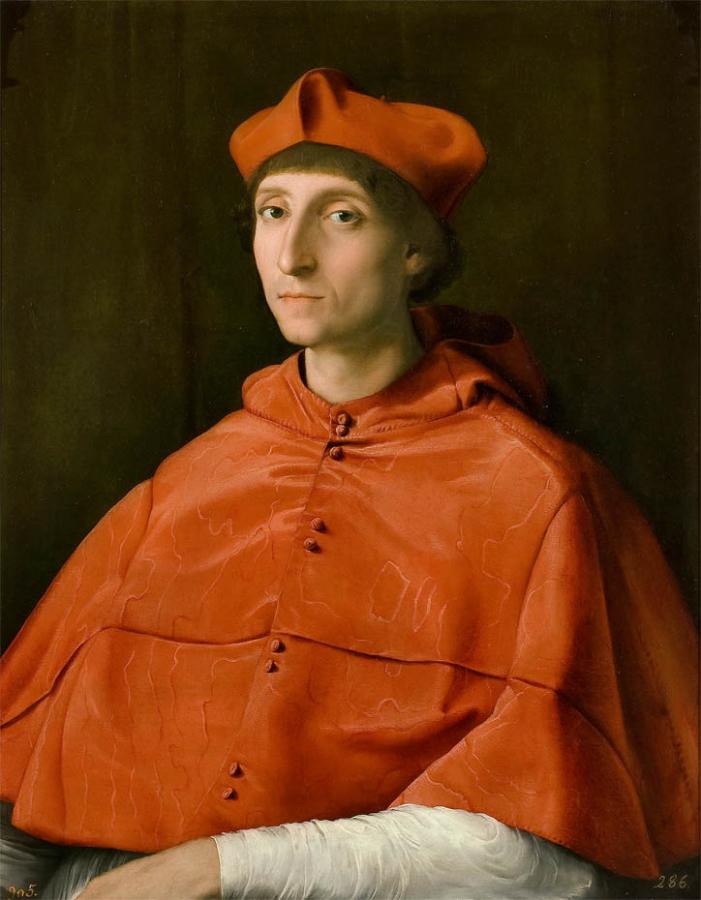Raffaello (1483-1520)
Ritratto di cardinale (Portrait of a Cardinal)
1510–1511
Oil on panel, 79 x 61 cm
Museo del Prado, Madrid
Since the moment when it was decided that the present work is by Raphael but that the sitter is not Antonio Granvela, art historians have expended considerable efforts on identifying the sitter.The most credible candidates would seem to be Cardinal Bendinello Suardi (painted by Del Piombo, Washington, National Gallery of Art), and even more probably Cardinal Giovanni Alidosi (depicted on a medal and also in the Disputa in the Stanza della Segnatura), due to the latter’s clear resemblance to the present sitter. However, neither can be clearly identified with the features of this cardinal. Aside from the high quality of the execution, the most striking aspect of this portrait is Raphael’s astonishing natural perceptiveness which results in the definitive and universal image of a Renaissance cardinal (this painting is always referred to as The Cardinal rather than ‘Portrait of a Cardinal)’.The artist achieves this, however, without renouncing a depiction of the individual nature of this sitter, using his way of ‘painting people as more real than they are’, in Bembo’s words. This ability to imitate nature derives from the Flemish portrait, which Italian painters of the second half of the Quattrocento studied with enormous interest. Flemish influence is evident in the masterly modelling of the face, for example in the way that Raphael moved the left eye (a pentimento now visible to the naked eye) to achieve a more penetrating gaze through the contrast with the direction of the turn of the head. The bold handling of the textures of the clothes, such as the sheen on the red silk cape, reveals a direct knowledge of Venetian painting. A point of reference may well be Lorenzo Lotto’s presence in the Vatican in 1509, and his influence on Raphael in the portraits of the figures on the right-hand side of The Mass at Bolsena has been noted on various occasions. In addition, the geometrical rigour of Lotto’s portrait of Bernardo de Rossi may have inspired the markedly hieratic nature of the present cardinal. The painting can be dated to around 1510, the year in which Alidosi died, through its similarity to Raphael’s portrait of Leon X in the National Gallery, London. Its triangular composition clearly derives from Leonardo, in particular the Mona Lisa, evident in the (slightly incorrect) placement of the arm in the foreground whose intention is to diminish the distance between sitter and viewer.The cardinal’s body is reduced to a pyramidal form which acts as a mere support for the head in the manner of Quattrocento Florentine sculpted busts, which do not include arms or other details that detract attention from the face. In this way, and with the figure emerging from a black background that emphasises the sense of his real presence, Raphael imbued his sitter with the solemnity of a statue, creating an unforgettable image in which this individual (as this is, after all, the physical and psychological representation of an individual) becomes the paradigm of the ecclesiastical dignitary that he represents. This is so much the case that art historians attempting to identify the sitter have frequently consulted biographies of cardinals of the day to find one with the refined, astute and impenetrable character of this figure, who certainly corresponds well to Bembo’s description of Cardinal Alidosi: ‘for whom faith and religion were never by any means certain, pure or sacred.’
(El retrato del Renacimiento, Museo Nacional del Prado, 2008, p.212-213).
